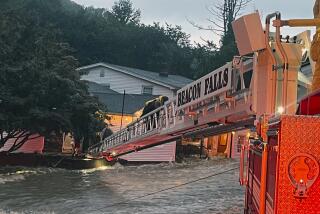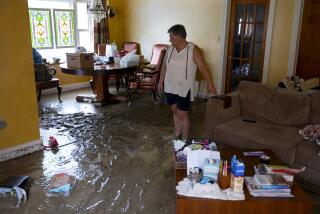Illinois tornado survivors dig out from the wreckage
WASHINGTON, Ill. — The tornado that leveled Beth and Dennis Doolans’ home scattered their belongings like trash, a fate shared by many residents in the twisters’ path.
Sometime later and some 80 miles away, a photograph fluttered into a yard. It was one of the Doolans’ favorites, taken on their 40th anniversary. A friend spotted it on a Facebook page for lost possessions and contacted the Doolans’ daughter Monday.
“There were tears of joy when I told them,” said their daughter, Lisa Hoffman.
The Doolans were among the survivors of a spate of twisters and thunderstorms that pummeled a broad swath of the Midwest on Sunday.
Eight people were reported killed, including six in Illinois and two in Michigan, and dozens were hurt. National Weather Service meteorologists estimated that as many as a dozen tornadoes touched down, crushing scores of homes and injuring people with flying debris.
The storms also struck Missouri, Indiana, Kentucky, Tennessee and Ohio, but Illinois took the brunt of the damage. Gov. Pat Quinn called the storms “the deadliest series of tornadoes Illinois has ever had in the month of November.”
Two Illinois twisters could have had winds up to 200 mph, meteorologists said, which would also make them the most powerful November twisters on record in the state.
The tornado that pummeled Washington tracked through four counties and covered nearly 50 miles, staying on the ground for nearly an hour, the weather service said. It left an apocalyptic landscape snarled with plywood, drywall, twisted metal and remnants of ordinary lives: a bike helmet, a T-shirt, a basketball.
“The devastation is just unbelievable,” Washington Mayor Gary Manier said. “I can’t imagine people walked away from these places.”
Lorelei Cox, a teacher, and her husband, Dave, were trapped in the debris of their home after the storm hit and were dug out by a former student of hers.
On Monday, when they returned to the devastated area to try to retrieve some belongings, she wasn’t sure where their two-story home was. Her Volkswagen ended up in the backyard. Dave Cox said he still hadn’t found his SUV — which had been parked in the driveway — or his wallet.
Lorelei Cox had only enough time to grab her purse, her phone and their dog. Dave Cox left with nothing — not even shoes.
“It’s just stuff. That’s what I keep telling myself,” Lorelei Cox said.
Steven Neubauer, 51, was Washington’s lone reported fatality. His neighbor Lori Anne Hagey said he hadn’t been able to reach his basement.
Hundreds of Washington residents came to Crossroads Methodist Church for a place to sleep, a warm meal or just companionship, the Rev. Tom Goodell said.
“People more than anything are just in shock,” he said. “They want to come in, want to be around other people, want to have people sit with them, pray with them, offer them hot coffee.”
In Massac County, which rests along Illinois’ rural southern tip, a tornado pounced on the tiny bedroom communities of Brookport and Unionville, claiming three lives and at least 50 homes.
Larry Douglas, a volunteer and former manager of the Massac County Emergency Services and Disaster Agency, said Brookport had few basements because it’s a river town.
“It’s just a sitting duck,” Douglas said. “We’re becoming tornado alley here. The weather, it’s all mixed up.”
In late October and early November, Illinois typically has what weather service meteorologist Dan Smith described as a “second peak” of turbulent weather, when it’s “not out of the question” to get tornadoes. But, he added, the magnitude of these storms was unusual for November.
Last week, forecasters watched as a low-pressure system forced moisture north over the Midwest, colliding with strong winds and a cold front pushing eastward.
Moisture plus strong winds and 70-degree temperatures equal trouble. The weather service called the ensuing instability “off the charts” for November.
Since record-keeping began in 1885, there had been more than three dozen moderate-strength November tornadoes in Illinois, but there had never been such a strong tornado “until this year,” the weather service said.
Nearer Chicago, in the Coal City and Diamond area, the whines of power saws and rapping of hammers filled the air as crews removed debris and patched or secured damaged roofs.
Scott Hammitt, who lives in Diamond, spent Monday stuffing belongings into trash bags and photographing the damage for his insurance claim. He said his insurance company told him an adjuster wouldn’t be available until next week. Until then, he said, he’s staying with a friend.
“I’m going to see if I can get someone to board up the house, but you don’t know who’s trustworthy,” he said, glancing at his ruined living room. “Then again, how do you board up a roof, or the walls?”
Pearce reported from Los Angeles and Manchir and Rubin from Washington, Ill. Lauren Zumbach, Carlos Sadovi and Cynthia Dizikes in Chicago and Andy Grimm in Diamond, Ill., contributed to this report.
More to Read
Sign up for Essential California
The most important California stories and recommendations in your inbox every morning.
You may occasionally receive promotional content from the Los Angeles Times.











